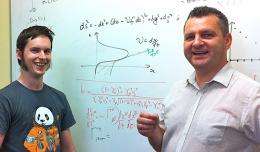The annihilating effects of space travel

Long distance space travel could create the ultimate 'killer entrance', devastating your destination and anything around the arriving spacecraft, according to calculations by Professor Geraint Lewis and two honours students from the University of Sydney.
The University of Sydney team is the first to publish on the effects of theoretical space travel using an Alcubierre warp drive, in the leading journal of the American Physical Society, Physical Review D.
The Alcubierre warp drive is a theoretical tool that would allow spacecraft to travel long distances in space rapidly by deforming the space-time continuum in a bubble around the spaceship.
Miguel Alcubierre, a Mexican physicist, proposed this warp drive in 1994 as a way to travel faster than light, overcoming the limit on particles travelling at such speeds posed by Einstein's theory of special relativity.
"When the spacecraft decelerates to stop at its destination, the particles collected at the front of the spacecraft are released with such high-energy that they would destroy anything they came in contact with. During the journey the particles picked up and included inside the bubble could threaten the safety of people travelling in the spacecraft," said Professor Geraint Lews from the School of Physics.
Brendan McMonigal and Philip O'Byrne, who completed their Bachelor of Science with Honours in Physics in 2011 and 2010 respectively, both worked with Professor Lewis, their supervisor.
"It sounds like it's straight from science fiction, and in a way it is, as the Alcubierre warp drive is a theoretical solution to the problem of travelling the huge distances in space in a reasonable amount of time," said Professor Lewis. "But unlike science fiction, the Alcubierre warp drive completely obeys Einstein's general theory of relativity."
"All innovations start with theory, however, so these calculations contribute to our understanding of how such speeds could be achieved. Our team decided to consider what would happen to particles and radiation that a spacecraft, travelling in a bubble created by the Alcubierre warp drive, would come across as it travelled through space," explained Professor Lewis.
"What we've shown is that when this spacecraft decelerated to arrive at its destination, it would release high energy particles which would destroy anything near the spacecraft's landing spot."
While scientists have examined how it's theoretically possible to create a bubble around a spacecraft with the Alcubierre warp drive compressing space-time in front of the bubble and expanding it behind the bubble, there has been little consideration of how this high-speed bubble would interact with particles of matter and light.
"Our calculations show that particles that come in contact with the warp bubble can get caught up and congregate in front of the spacecraft, and some particles even enter the warp bubble," said Professor Lewis.
Brendan McMonigal, one of the honours students working on the research, said, "Interestingly, the energy burst released upon arriving at the destination does not have an upper limit. You can just keep on traveling for longer and longer distances and the energy that will be released will continue to increase - one of the odd effects of General Relativity."
"Even for very short journeys the energy released is so large that you would completely obliterate anything in front of you," said Brendan.
"It seems that human exploration of the universe will have to wait until we've worked out how to avoid the destructive deceleration of a spacecraft in an Alcubierre warp drive bubble."
While the study may seem like a fun theoretical consideration, exploring the implications of Einstein's theory of relativity is significant and has all sorts of practical uses, such as relativity correctors for GPS systems, found in virtually all smartphones, that correct for the time difference between the ground and satellite.
Journal information: Physical Review D
Provided by University of Sydney
















